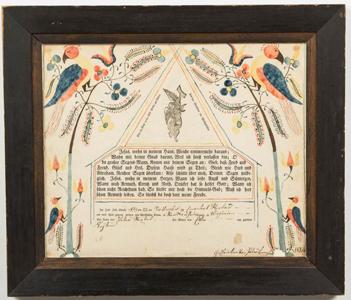The Antiques Addict: Manuscript Art of the Pennsylvania Germans
By • February 18, 2016 0 1819

Between 1720 and 1820, more than 100,000 German-speaking people entered the port of Philadelphia seeking a life free from religious persecution. Most were peasants and small farmers, and they eventually moved from the city to the fertile soil of southeastern Pennsylvania. Later generations traveled further south into the Shenandoah Valley, Maryland, Virginia and the Carolinas.
Although agriculture was their major industry, as their society became more firmly rooted, farmer-craftsmen turned some of their energies to producing and decorating the many articles of daily life, including “fraktur” — illuminated documents recording family events. The name fraktur derives from the angular, fractured appearance of the familiar Gothic typeface used in deeds and official edicts in 16th-century Europe.
The fraktur artist held several positions within the Pennsylvania German community. As the representative of learning, he was often the schoolmaster as well as clergyman. With his skills in drawing and writing, he performed such services as illustrating books and hymnals and drawing up important documents. These sunny creations contrasted with much of the religious art of the time, since sin and pain were rarely depicted.
Pennsylvania Germans usually made fraktur for personal use, and instead of hanging fraktur in their homes, people most often rolled-up fraktur documents and tucked them away, pasted them underneath the lids of storage chests, or kept them neatly folded inside books and Bibles. The great care many Pennsylvania Germans took to preserve these documents is a touching reminder that fraktur commemorated important and personal life events.
Fraktur — especially birth and baptismal certificates — became very popular by the late 1700s. By 1780, various communities developed fraktur printing presses in order to create more fraktur works in a shorter amount of time. Many professional fraktur artists used these printed “blanks” to keep up with client demand. Artists continued to personalize each mass-produced document.
These printed forms were often sold by itinerants and at rural stores. A skilled calligrapher, perhaps the itinerant himself, would fill in the clients’ personal information and often hand-color or embellish the printed designs with borders and outlines of birds, flowers and other decorative flourishes. Although they are not strictly speaking “certificates,” since no one in authority signed them, they have been regarded as legal documents. Since law in the old country required such documents, the tradition was continued in America.
Fraktur are some of the earliest examples of folk art found in the Shenandoah Valley. Though most Shenandoah Valley fraktur artists did not sign their work, several did. Peter Benhart, a Rockingham County schoolteacher and mail carrier, was one of the most prolific. He worked from about 1796 to 1819 and rode from his home near Keezletown to Winchester every other Wednesday to begin his postal route. He arrived in Rockingham County by Friday and finished the route in Staunton on Saturday. Bernhart functioned as a post rider over this course for nearly thirty years, creating fraktur for clients along his route.
He nearly always included not only his name, but also the date of when he made the fraktur. Many of his paintings were created on pre-printed blanks produced for him by local printers. He would carry the forms with him on his routes, and when called upon to produce fraktur, he would fill in the blanks with the pertinent information, then embellish the document with by painting around the borders. Although his paintings were often crudely executed, including poor spelling, his creations showed a unique style with amusing designs and bright colors.
Another Valley fraktur artist, who has only been identified as simply the Stony Creek Artist, produced works in German and English. Often, his paintings depicted cherubs, drawn-back curtains and hearts.
These Valley fraktur artists provide an important key to the important families of the Shenandoah Valley during the 18th and 19th centuries.
Traditional fraktur designs of the 19th century feature pomegranates, angels, trees, flowers and birds. The intricacy of design, selection of color and particular historical relevance to a family or place are factors that affect the current price of a painting. Prices of fraktur done by preeminent artists have soared into the $10,000 to $50,000 range. Although a piece by Peter Bernhart recently sold at auction for $15,500, against its estimate of $8,000-$12,000, some beautifully rendered examples by lesser-known artists can still be found for under $1,000.
Michelle Galler is an antiques dealer, design consultant and realtor based in Georgetown. Her shop is in Rare Finds, in Washington, Virginia. Contact her at antiques.and.whimsies@gmail.com.

